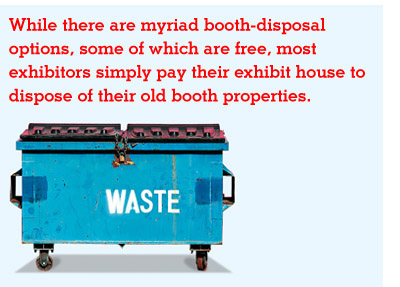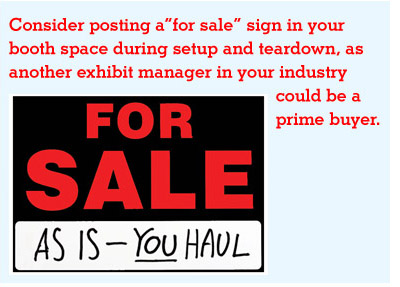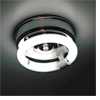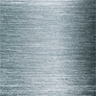booth disposal |
 |
 |
 |
 |
 ore often than not, it's easy to tell when something should be thrown away - and exactly what type of disposal method is appropriate. If your socks have more holes than a can of SpaghettiOs, they're headed for the trash bin. If the moo-shu pork you ordered last week has grown fur, it's going down the disposal. And if your dog's stuffed bunny has lost its ears, an eye, and three of its legs, it's off to the curbside garbage can where Mr. Pootie can't get it, assuming you can pry it from his jaws first. ore often than not, it's easy to tell when something should be thrown away - and exactly what type of disposal method is appropriate. If your socks have more holes than a can of SpaghettiOs, they're headed for the trash bin. If the moo-shu pork you ordered last week has grown fur, it's going down the disposal. And if your dog's stuffed bunny has lost its ears, an eye, and three of its legs, it's off to the curbside garbage can where Mr. Pootie can't get it, assuming you can pry it from his jaws first. |
But knowing when and where to dispose of your trade show exhibit isn't quite that easy. Sure, the industry's rule of thumb says you'll get three to five years out of a typical exhibit. But what if your entire marketing strategy changed when your booth was just two years of age? Or what if 80 percent of your exhibit still looks great at age seven? When industry averages don't seem to apply, how do you know when to keep your booth as is, refurbish it, or pull the plug?
And even if you've determined your booth is undeniably dead, what do you do with the carcass? Your exhibit may be small enough to stuff into your company's dumpster, but doing so likely wastes precious recyclable materials - and it might even be illegal depending on city and state dumping codes. What's more, if you're stuck with a rotting behemoth that fits in a dumpster about as well as Shaq fits in a Smart car, you could end up paying your exhibit house thousands of dollars to simply chuck it into a landfill. Talk about an ROI that's DOA.
To answer these questions and more, EXHIBITOR asked eight industry experts for their advice on this fascinating yet somewhat morose topic. Including everything from a list of potentially fatal exhibit flaws to six innovative disposal methods, their advice will help you determine when you should try to breathe life into your old booth, and how you can bury the dead without breaking the bank.
Check for a Financial Pulse
If you're trying to decide whether to keep the booth you've got, refurbish it, or start from scratch, you first need to make sure there's cash flowing from your company's coffers into your exhibit budget. Begin by determining what, if any, budget is available for a new or refurbished booth. If your funds are frozen, your decision is probably made for you, unless you can prove a new booth or refurb will save money long term. But if there's cash available, determine roughly how much you have, as this knowledge will steer the rest of your decisions.
 "Next, examine the exhibit's depreciation schedule," says Sean Combs, president of Steelhead Productions, a Las Vegas exhibit house specializing in rental properties. "When an exhibitor purchases a booth, the purchasing company depreciates the cost over several years. In effect, the exhibit is 'on the books,' for the length of the depreciation. So if your booth hasn't fully depreciated and you buy a new one, you've basically got two booths 'on the books.' And if shareholders or analysts look at these accounting records, two depreciating costs are far less favorable than one." "Next, examine the exhibit's depreciation schedule," says Sean Combs, president of Steelhead Productions, a Las Vegas exhibit house specializing in rental properties. "When an exhibitor purchases a booth, the purchasing company depreciates the cost over several years. In effect, the exhibit is 'on the books,' for the length of the depreciation. So if your booth hasn't fully depreciated and you buy a new one, you've basically got two booths 'on the books.' And if shareholders or analysts look at these accounting records, two depreciating costs are far less favorable than one."
Our experts caution, however, that just because a booth isn't fully depreciated doesn't mean it can't be abandoned. But understanding its place on the balance sheet is a critical and sometimes overlooked step in the decision-making process.
Another consideration is your exhibit's logistical expenses. "Drayage, shipping, storage, and I&D expenditures can make a booth too cost prohibitive to use," says Craig Holley, vice president of marketing communications at Gallo, an event, exhibit, and environment design and production firm in Cuyahoga Heights, OH.
So if weight- and material-related costs and restrictions are busting your budget, ask your exhibit house to do a line-item comparison between your current exhibit and one that weighs less and is made of components or materials that would lower your operating expenses while also meeting your objectives. "Assess the operational costs of your current property compared to the acquisition and operational costs of a new property over the course of two years," says Marty McGreevy, president of Cyclonix Inc., an exhibit and event firm in Morgan Hill, CA. "You may determine that a new booth will actually pay for itself in a couple of years given the operational cost savings it will produce."
The same concept applies to refurbishment. Ask your exhibit house to run the numbers, comparing your current exhibit against refurbishments that can lower your logistics expenses. Again, refurbishments might pay for themselves if they significantly lower your operating costs.
Your final financial consideration is the cost of disposal. While there are myriad booth-disposal options (see page 31), some of which are free, most exhibitors simply pay their exhibit house to dispose of their old booth properties.
"Booth-disposal fees vary widely according to how much of the booth is recycled, the presence of hazardous materials, the number of crates or skids involved, and the landfill method used," says John Driscoll, president of Showcraft Inc., an exhibit house in Burnsville, MN. "But disposing of a 20-by-20-foot property can run upwards of $2,000." And a 50-by-50-foot property might just break the bank. So consider the disposal methods you'll use and any fees you'll incur before you decide to give your booth the ol' heave ho.
Look for Changes in Appearance
By now, you should know whether a new exhibit or refurbishment is financially feasible. But just because it seems like you can afford it, doesn't mean you should buy it.
Before you make a decision about the future of your booth, analyze its physical characteristics and the literal and subliminal messages it sends attendees. Especially if you've recently undergone a merger, product launch, market realignment, rebrand, etc., carefully assess whether your booth's appearance and messages support your current marketing objectives.
"Are your exhibit finishes, materials,
and colors worn or outdated? If so, your exhibit probably isn't sending the type of message you want to communicate to attendees," Holley says. "Also consider your graphics messages as well as the nonverbal cues your exhibit gives attendees. Are those messages on par with your current product and brand messages? Have the same attendees seen this booth year after year, sending a subliminal message that your company is complacent and stale? Answering 'yes' to these questions doesn't mean you have to trash your booth and start anew. But your exhibit is a marketing machine, and if it doesn't meet your marketing objectives, you could just as well stick a pop-up tent in your space."
So if you're financially able to build a new booth or refurb the one you have, and you've answered "yes" to many of these marketing questions, you're probably better off trashing all or part of your exhibit property. If, on the other hand, you've answered "no" to many of these questions, your booth may simply need a bit of refurbishment, or no changes at all, to keep it aligned with your financial and marketing needs.
Schedule an EAE
The aforementioned financial and marketing considerations will help you decide if you should build new, refurb, or simply keep your existing exhibit as is. But Driscoll suggests you also perform an exhibit asset evaluation (EAE) before you act.
Gather all of your notes, reports, thoughts, records, etc. regarding your current exhibit property's financial and marketing shortcomings, and schedule a meeting with your exhibit house, he says. Prior to the meeting, note any additional perceived deficiencies in the exhibit. Perhaps the architecture isn't easily reconfigurable, or attendee traffic always jams up near the product displays during shows. Also document what areas or elements of the exhibit work particularly well that you wouldn't want to change. Then gather any descriptive assets that still exist from the original exhibit production, including shop drawings, crate manifests, CAD assembly drawings, photos, material specs, etc. These assets will not only help your exhibit house determine how it might reuse or reconfigure elements, but if you were to sell or rent your booth to someone else, this information is often requested by interested parties.
Documents in hand, sit down with your exhibit house, explain your dilemma, and ask that it assist you in analyzing the pros and cons of each option. This isn't a condensed RFP process, but rather a constructive conversation to help you make a critical, and expensive, decision - and to help you identify alternatives you may never have considered.
 Plus, this conversation will help you gauge the company's willingness to assist you with refurbishing or discarding your old property. If the company is focused on a new booth regardless of your budget or objectives, it might be time to look for a new exhibit house.
Plus, this conversation will help you gauge the company's willingness to assist you with refurbishing or discarding your old property. If the company is focused on a new booth regardless of your budget or objectives, it might be time to look for a new exhibit house.
Select a Burial Method
After applying the aforementioned decision-making strategies, you may decide that your old booth still has a few good years left. (And if so, you can count yourself lucky, especially given the current state of the economy.) But if you decide you need to resuscitate your exhibit with a significant refurbishment or you want to start from scratch and build a whole new booth, you need to determine how best to dispose of various booth components or perhaps your entire exhibit. Here are six different disposal methods to consider.
 Pay your exhibit house to discard it. Pay your exhibit house to discard it.
Almost all exhibit houses will dispose of your exhibit property for a fee. But the manner in which they dispose of the property and the fees they charge to do so vary greatly. To give you a ballpark, Driscoll estimates that disposal fees for a 20-by-20-foot booth are roughly $2,350. That figure includes a $300 to $500 fee for a rented dumpster to transport the material to a landfill, hazardous recycling fees of approximately $250 for materials such as fluorescent bulbs, and labor charges (including two men for approximately eight hours each) to break down the exhibit and its crates into manageable pieces.
The amount of recycling involved
in disposal also varies dramatically. While some exhibit houses chuck the whole exhibit property into a dumpster, Gallo, for example, uses an extensive recycling process. "We separate exhibit materials into piles, including wood, plastics, steel, aluminum, light fixtures, bulbs, padding, etc., and send them to the appropriate recycling facilities," Holley says.
Paying your exhibit house to discard your booth property requires little more than signing a contract and writing a check. But depending on the amount of recycling involved and compared to the alternatives, it might be the most expensive and the least eco-conscious option.
 Leave your booth at its last show. Leave your booth at its last show.
"Another relatively easy way to dispose of a booth is to discard it at its last show," says Scott Stallings, director of exhibitor sales at Las Vegas-based Freeman Co. "Every situation is different, but you'll probably have to make special arrangements with the general contractor, your I&D crew, and/or show management. Likely, you'll also pay a disposal fee to the general contractor, much as you would if you'd disposed of your booth through your exhibit house. However, you won't pay for the booth's return shipping, and you may even decrease dismantle time and costs."
To make this option a little Greener, McGreevy suggests that you work with your exhibit house and I&D crew prior to the show to make a list of your recyclable exhibit materials and recycling centers that accept each type of material. During teardown, your I&D crew can segregate the materials, load them into your shipping containers, and ship them to the appropriate recycling locations. That way, only non-recyclable items end up in the convention-center dumpster.
 Sell it yourself. Sell it yourself.
You can certainly sell an exhibit property via countless mass-marketing tools, such as eBay, local classified ads, Craigslist, etc. But the chances that another exhibitor, much less one who needs the exact same functions and aesthetics your booth offers, will see your ad and act upon it are slim. So you're probably better off selling your property via a medium specific to the trade show industry.
One option is an online exhibit broker, such as World Exhibit Brokers (www.webisales.com) or Lucky Exhibits (www.luckyexhibits.com) - which will attempt to sell your exhibit on your behalf for a fee or a portion of the profit. Or, you can market the exhibit yourself via online exhibit-sales tools such as ExhibitTrader.com and ExhibitAuction.com. Also consider placing an ad in the classified or directory sections of industry publications and Web sites, such as EXHIBITOR's own Resource Directory, which is available in print and online.
In addition, get the word out to your suppliers and industry peers. Your transportation carrier, for example, may have another client that's looking for a booth, or perhaps your exhibit house has a cash-poor client looking for exhibit components just like yours. Also, consider posting a "for sale" sign in your booth space during setup and teardown, as another exhibit manager in your industry could be a prime buyer.
With most of these options, you'll need some marketing tools to present your property in the best light and to
provide buyers with critical information, says David Lucky, president of Lucky Exhibits in Las Vegas. So assemble accurate and detailed descriptions of your property, such as component measurements, colors, required wattage, etc., along with quality exhibit photos, detailed renderings, blueprints, and more.
 Sell it back to your exhibit house. Sell it back to your exhibit house.
"Especially if you're buying a new booth from your exhibit house, you can try to sell back your old property or portions of it to the same firm," says Brad Hogan, president of Pinnacle Exhibits in Hillsboro, OR. "Versatile elements such as bars, walls, double-deck structures, etc. can often be repurchased as rental inventory or refurbished for other clients."
 But don't expect a lot of money from the sale. Daniel Chaddock, president of E&E Exhibit Solutions in Tempe, AZ, estimates that exhibitors selling a property (or parts of it) back to their exhibit houses will get 10 cents on the dollar. "If your exhibit cost you $40,000, you might get a $4,000 credit toward the purchase of a new booth." Plus, since your exhibit house may be collecting sizeable storage fees for your old property and it may need to spend money to refurbish your components before they can be reused or rented, some firms aren't eager to buy back exhibits. But don't expect a lot of money from the sale. Daniel Chaddock, president of E&E Exhibit Solutions in Tempe, AZ, estimates that exhibitors selling a property (or parts of it) back to their exhibit houses will get 10 cents on the dollar. "If your exhibit cost you $40,000, you might get a $4,000 credit toward the purchase of a new booth." Plus, since your exhibit house may be collecting sizeable storage fees for your old property and it may need to spend money to refurbish your components before they can be reused or rented, some firms aren't eager to buy back exhibits.
Meanwhile, other firms actually have buy-back programs in place. Cyclonix, for example, offers two options. "With one option, the client gives us their old property free and clear, and we rent it out to other people," McGreevy says. "That way, they don't incur a disposal feel or any more storage fees. With the second option, we rent the property to other clients and split the revenue with the exhibit's owner, who continues to pay storage and eventually pays for disposal."
Cyclonix also offers a "Bucks for Booths" program, similar to many exhibit houses' promotional buy-back programs. In exchange for old exhibits, Cyclonix will give exhibitors up to a $5,000 credit toward the purchase of one of its custom/modular booths. The company will even pick up and transport your clunker to its headquarters for stripping, recycling, and disposal.
 Donate it to charity. Donate it to charity.
"Particularly with portable/modular exhibits, which are easy to refurb, donating them to charities, schools, or churches is a wonderful way to extend their use - not to mention a clever way to avoid disposal fees and secure a tax write-off at the same time," Stallings says.
Finding a charity that can use your entire booth will require some research, and you may end up paying for transportation to get the exhibit to the charity's headquarters. But if you think beyond typical uses for your booth, you may find local charities that will accept many of your components and possibly even pick them up.
For example, E&E Exhibit Solutions
donated used exhibit carpet to low-income housing projects, while Pinnacle Exhibits donated lightly worn exhibit furniture and cabinetry
to Habitat for Humanity. With some research and a bit of creative thinking, you could score a tax write-off and warm fuzzies to boot.
 Repurpose it within your company. Repurpose it within your company.
Just as charities can repurpose booth components, so can departments or divisions within your company. Holley used a client's back-wall structure - which had previously been headed to the landfill - to construct an outdoor patio at his company's headquarters.
If appropriate, send a company-wide e-mail noting the exhibit items available, and asking if there is any personal or departmental need for them. For example, your company's break room could be the perfect location for your exhibit's bistro tables. Or maybe the 3-D logo that used to hang over your booth could be displayed in the office lobby. Even whimsical tension-fabric structures might add levity to the company picnic.
Employees may be willing to buy items from you - or you can auction them off for nominal fees and either donate the proceeds to charity or put them toward your program's new build. Again, any item you can reuse or repurpose is one less item stuffed into a landfill, and one less thing you have to pay to dispose of.
So whether you decide to resuscitate your old exhibit or simply kick it to the curb, thanks to our experts' advice, the decision-making process should be a whole lot easier. Plus, if you decide you've been beating a dead-horse booth, you've got six different ways to put it out to pasture. E
|
|
MATERIAL HANDLING
When you're trying to decide whether to reuse your old booth, refurbish it, or simply start anew, it helps to know what materials are easy to reuse, and which ones you'll probably need to throw away sooner rather than later. Here's a list of some of the most common exhibit materials and their reuse recommendations.

| |
|
 |
Laminate - Given its propensity to chip and scratch, laminate isn't a refurbishment option in itself. However, items covered in laminate can usually be refurbished by replacing the laminate (preferably using a brand with low volatile organic compounds).
|
 |
Wood - Wood structures are usually easy to resurface, but lighter- weight bamboo might be a more cost-effective and potentially Greener option for new components.
|
 |
Fluorescent Bulbs - While they're typically used over and over again, fluorescent bulbs contain mercury, which is toxic and can't be sent to landfills. Instead, you must dispose of them via a hazardous-waste program.
|
 |
Plexiglas - Plexiglas scratches easily, and these blemishes are impossible to remove without further reducing the material's transparency. So Plexiglas has very little reuse potential, but it can typically be recycled along with other plastics.
|
 |
Modular Aluminum - Aluminum components can be adapted to various designs; plus, the material is recyclable and lightweight. However, fabrics and graphic substrates (which are often used over the aluminum) are rarely reusable.
|
 |
Metal - Generally speaking, you can reuse or repaint most metals as long as you haven't drilled a lot of holes in them.
|
 |
Gas-Filled Plasmas and Monitors - The gas inside these items is hazardous, so you must use a hazardous-waste program to dispose of them.
|
 |
Carpet - While many people throw out used exhibit carpet, it can often be repaired for extended use. Plus, it can be re-dyed to match a new color scheme. If your carpet has outlived its usefulness, many carpet manufacturers will recycle it for you.
|
 |
Fabric - Lightweight, flexible, and generally easy to produce and transport, fabric can sometimes be cleaned, but it's rarely refurbished or reprinted.
|
|
|
|





 "Next, examine the exhibit's depreciation schedule," says Sean Combs, president of Steelhead Productions, a Las Vegas exhibit house specializing in rental properties. "When an exhibitor purchases a booth, the purchasing company depreciates the cost over several years. In effect, the exhibit is 'on the books,' for the length of the depreciation. So if your booth hasn't fully depreciated and you buy a new one, you've basically got two booths 'on the books.' And if shareholders or analysts look at these accounting records, two depreciating costs are far less favorable than one."
"Next, examine the exhibit's depreciation schedule," says Sean Combs, president of Steelhead Productions, a Las Vegas exhibit house specializing in rental properties. "When an exhibitor purchases a booth, the purchasing company depreciates the cost over several years. In effect, the exhibit is 'on the books,' for the length of the depreciation. So if your booth hasn't fully depreciated and you buy a new one, you've basically got two booths 'on the books.' And if shareholders or analysts look at these accounting records, two depreciating costs are far less favorable than one." Plus, this conversation will help you gauge the company's willingness to assist you with refurbishing or discarding your old property. If the company is focused on a new booth regardless of your budget or objectives, it might be time to look for a new exhibit house.
Plus, this conversation will help you gauge the company's willingness to assist you with refurbishing or discarding your old property. If the company is focused on a new booth regardless of your budget or objectives, it might be time to look for a new exhibit house. But don't expect a lot of money from the sale. Daniel Chaddock, president of E&E Exhibit Solutions in Tempe, AZ, estimates that exhibitors selling a property (or parts of it) back to their exhibit houses will get 10 cents on the dollar. "If your exhibit cost you $40,000, you might get a $4,000 credit toward the purchase of a new booth." Plus, since your exhibit house may be collecting sizeable storage fees for your old property and it may need to spend money to refurbish your components before they can be reused or rented, some firms aren't eager to buy back exhibits.
But don't expect a lot of money from the sale. Daniel Chaddock, president of E&E Exhibit Solutions in Tempe, AZ, estimates that exhibitors selling a property (or parts of it) back to their exhibit houses will get 10 cents on the dollar. "If your exhibit cost you $40,000, you might get a $4,000 credit toward the purchase of a new booth." Plus, since your exhibit house may be collecting sizeable storage fees for your old property and it may need to spend money to refurbish your components before they can be reused or rented, some firms aren't eager to buy back exhibits. 











